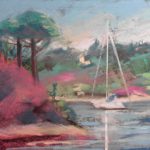
Many artists are often asked by friends or through referrals to paint commissions of specific subjects. Negotiating that area between artistic expression, visual license and expectation when painting for a client with a specific idea, can be tricky. Stress commonly accompanies art making when the artist is mindful of the need to produce something pleasing to the client. Colin Christie, UK artist, recently sent us a description of his working methodology for landscape commissions which he has developed so that the painting process is stress free.
The brief for this commission was to produce a painting of his client’s yacht set in their favourite bay on the west coast of Scotland.
The first task is always creating a pencil sketch of a pleasant composition but to develop it in such a way that it makes a convincing view of the subject. Getting the scale of the yacht right here in relation to the landscape was achieved by tracing and reworking an actual photo of the yacht in an initial pencil outline on top of the landscape sketch and then transferring it to a pencil sketch on canvas.
This is then followed by a pastel colour sketch to determine the colours to be used in the painting. He uses this method as the quickest way to work out colour relationships, saving a lot of time when the major painting begins.
Following this, step 3 is to create a slightly more detailed colour painting to present to the client as the basis for the major work.
Colin has written,
“The ability of Interactive Acrylics to be reworked by re-moistening saves so much time compared with traditional acrylics……. I can slow up, rework, work additional colours into a section, wipe off if I want. It’s very liberating not to feel driven by the paint.
I (used to) do an acrylic under painting to work out all the compositional and colour problems and then complete the work in oils. However, since starting to use Interactive Acrylics I have found the need for an oil finish to be diminishing. Not only are the pigments so good but the flow of the paint allows a great deal more fluidity – the fluidity I used to require oils for.”
After viewing the preliminary painting the client wanted a change in the yacht’s presentation. To work out this change in the angle of the yacht, Colin went back to step 1, doing a fairly technical construction to get the angles sorted out, before transferring the amended and enlarged pencil sketch to the final board, 500 x 600mm, gessoed in a warm black ground.It helps a great deal in the final resolution to know that most of the compositional and colour problems have already been resolved.
About Atelier Interactive acrylics Colin says, ” I am also extremely impressed with the colour range. I can develop my pastel sketches safe in the knowledge that I can get the same tones and hues from the paint – Interactive Acrylics are now a core element in my working process.”
We’d love to hear from you about your experiences of doing commissions and thoughts on the process. Add a comment below.




